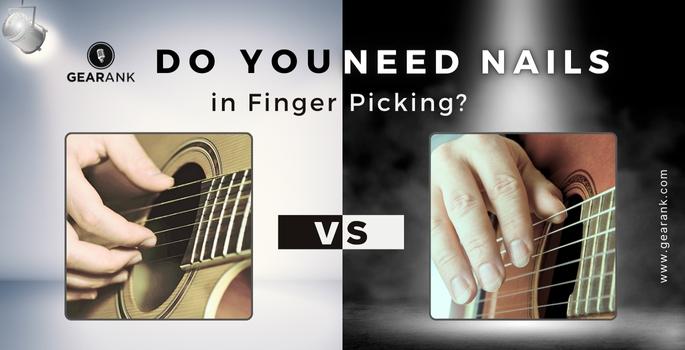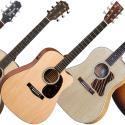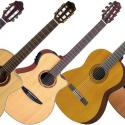Do You Need Nails to Finger Pick Like a Guru? Read Why Not

Many folk and classical guitar players have long nails that they use to pluck the strings. But there are others who have trimmed nails and still play well.
So the question is, do you need nails to finger pick? Is it really a must in classical style? How about electric or acoustic guitars?
To answer these questions, I'll show how guitarists are using their fingernails in guitar playing. I'll also show the strengths and disadvantages of both fingerpicking approaches.
After reading this, you'll have a better understanding of how you can use - or not use - your fingernails in your guitar playing.
What is Fingerpicking?
Fingerpicking refers to the act of plucking strings using your fingers. It is what constitutes fingerstyle, a style of playing guitar that mostly uses the fingers for picking and even strumming.
As the name implies, this technique requires nimble picking hand fingers, allowing for plucking multiple notes simultaneously.
Finger-picking is achieved by using the flesh of your fingers or by using nails. Most players use the fleshy part of their fingers or a guitar pick when playing.
But there are some who grow their fingernails and use them for playing. This includes classical guitar players, who use long nails to play according to established standards.
Note that extending your nails for guitar playing is exclusive to your playing hand. Long nails on your fretting hand will get in the way as you press the strings.
Here's a quick tip: Don't overtrim the nails on your fretting hand, because some nail growth can make fretting strings easier, especially when playing on a moderate to high guitar action.
There is also the option of equipping finger picks, which work like a guitar pick but are attached to your fingers.
Do You Need Nails to Finger Pick?
The answer is No, as evidenced by the many guitarists who play fingerstyle with trimmed nails. Historically, playing with the flesh on your fingers used to be the common way of playing before synthetic guitar strings like nylon strings or steel strings were introduced.
Guitars used to be fitted with gut strings, which could easily be damaged by fingernails. Musicians back in the day also used to play guitar in smaller venues, so they didn't need the louder output benefit of using nails.
Famous classical guitarists like Matteo Carcassi, Fernando Sor, and Francisco Tarrega (later in his life) were noted to prefer playing with no nails. It's worth noting that they liken the use of nails to adding special effects, which means that they knew that using fingernails changes the resulting sound.
Nowadays, most classical guitar players use nails in their playing, largely due to the influence of Andres Segovia, to the point that it has become a staple of this specific guitar style. So if you're into classical music, and want to play the "standard" way, then you should be playing with your fingernails.
Outside of classical music, there's no standard. In fact, modern fingerstyle virtuosos like Tommy Emmanuel, Joe Robinson, and Michael Fix use only their flesh in playing, and they all sound great. On the flipside, there are non-classical players who use fingernails to achieve good tone, including James Taylor, Mark Knopfler, Mike Dawes, and more.
Why Play Fingerstyle Guitar With Fingernails?
Because of the smaller contact area, playing with nails produces a loud and strong sound. It's also great for note articulation as you get clearer, crisp, and more defined notes.
This is important in musical genres like flamenco and classical. If you've somehow mastered playing all the right notes of Recuerdos de la Alhambra or Malagueña but still feel that something's not right, you're probably not playing with the correct right-hand technique, which involves the use of nails.
This allows you to access a wider tonal range as well. In addition to having the option of switching from flesh to nails and giving you more choices compared to those using flesh exclusively.
And this is not limited to just classical guitars, as exemplified by modern players who use their nails on acoustic and electric guitars, like Matteo Mancuso.
John Mayer is widely considered as one of the best fingerstyle guitarists today, he uses a combination of his finger tip and nail to get great-sounding tones out of his acoustic and electric guitars.
What is The Ideal Length and Shape of Finger Nails?
Generally, 2-3 mm is the standard nail length. Any longer than that can diminish your speed, but having very short nails will also affect your tone.
Alternatively, gauge your finger length by placing a flat surface against it. The ideal length should let both your flesh and nails touch the surface.
When it comes to nail shape, you must shape or file your fingernails in an angled and smooth way. Your fingers should be able to glide across and not get caught by the strings easily.
You can use nail cutters and nail files to achieve this.
How Do You Maintain Your Nails?
Fingernails are made up of keratin, the same as our hair. And similarly, we must also give special care to them to keep them in top condition.
-
Proper Shaping: A properly shaped nail should allow you to play smoothly. If you're having trouble with speed and clarity, check your nails to see if they're properly shaped.
-
Smoothen the Edges: To make sure that your nails don't catch the strings, file down the edges.
-
Repair Damaged Nails: Fix small cracks by using glue, or more ideally, bring them to a professional nail salon.
-
Moisturize: Dry nails tend to be brittle and are more prone to breakage. Use a moisturizer or cuticle oil on your nails.
-
Protect Your Nails: Use clear nail polish or hardeners to add strength.
-
Improve Your Diet: B-complex vitamins and biotin help avoid ridges along the nail bed. Calcium helps make your fingers less brittle, while folic acid and vitamin C help avoid hangnails. Lastly, take or eat foods rich in dietary essential oils like omega 3 for less cracking nails.
Pros and Cons of Playing With and Without Nails
Here are some pros and cons when playing with and without fingernails. This will give you a clearer perspective on the effects of utilizing both techniques.
Playing with Nails
| PROS | CONS |
| Louder and more robust sound | Requires fingernail maintenance. |
| Better note clarity | Fingernails are easily damaged |
| Crisp and bright sound | Can get in the way of daily activities |
| More expressive tonal range | |
| A must for classical guitar |
Playing without Nails
| PROS | CONS |
| Warmer, mellow sound | Lower volume output |
| No need for nail care | Limited tonal range |
| Better control and feel | Limits speed of playing |
The good thing about knowing how to play with your fingernails is that you also have the option of playing with just your fingertips. This means that you can use your nails to emphasize certain parts and then switch to just your fingers for a soft sound and mellow tone. You won't have this versatility when your nails are trimmed.
Final Thoughts
And so we're back to the main question - do you need nails to finger pick?
Playing with fingernails has a lot of benefits, but as discussed above, nails are not required to play fingerstyle.
Still, the benefits of playing with your nails should make you consider learning how to use them. It gives you more tone and expression options.
You get the benefit of a crisp and loud sound when using your nails, and you can easily go for a mellow sound by simply tweaking your fingers to not use your nails.
Frequently Asked Questions
Do I Have To Grow Nails To Play Louder?
It depends. If you're playing a classical guitar, growing your fingernails and using them will certainly help you play louder.
On the other hand, if you're playing an acoustic-electric or electric guitar, you don't necessarily need to. You can simply turn up the volume with the help of your amp or use a booster pedal.
Which is Better: Fingernails or a Guitar Pick?
Both have their pros and cons. Guitar picks allow for faster playing and allow for more aggressive playing styles. Fingernails, are more expressive and dynamic.
Thankfully, you don't really have to choose, since you can switch between picks and fingers with practice. So whichever your personal preference is, or what the song requires, you don't have to limit yourself.
So I'll answer this question with a guitar teacher's question: why would you limit yourself to one playing option? Learn to use both, and use them as needed by the music you're playing.
Can I Use Artificial Nails To Play Classical Guitar?
Yes, some guitarists use false nails, while others use nail wraps or gel coatings to give their nails some layer of protection.
For more heavy playing, fake nails made from plastic or acrylic nails are suitable. These nails are glued on top of your natural nails and give you a sturdier material to use in playing.
But nothing beats the feel of using real nails, so best follow our advice on fingernail maintenance. This is why nail care is of utmost importance in the classical world.
Contributors:
- Jerome Arcon - Co-writer
- Jerry Borillo - Illustrator












